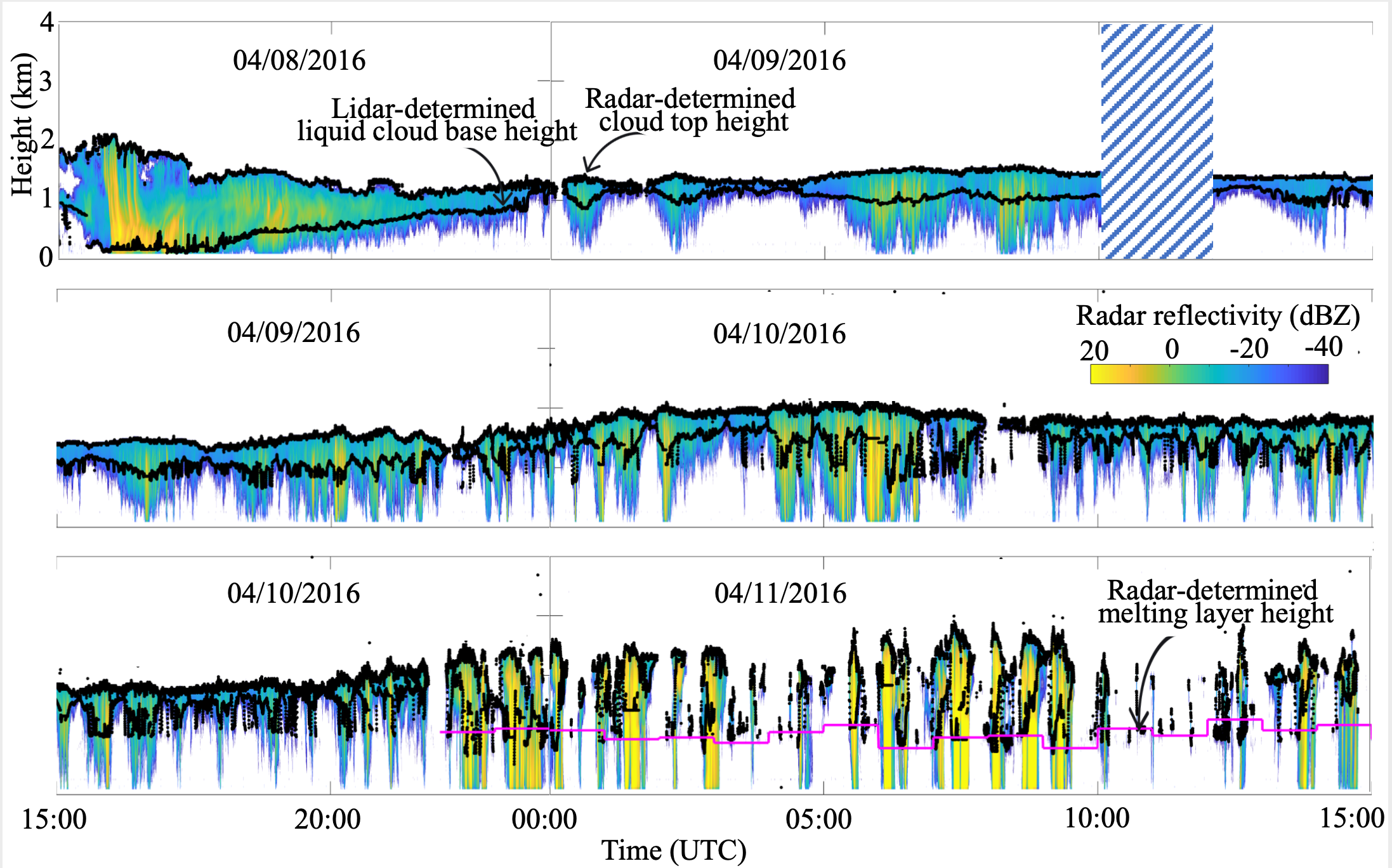Relationships between rain properties and large-scale conditions during subsidence in the ENA region
Submitter
Lamer, Katia — Brookhaven National Laboratory
Naud, Catherine M.
— Columbia University
Area of Research
Cloud-Aerosol-Precipitation Interactions
Journal Reference
Lamer K, C Naud, and J Booth. 2020. "Relationships between precipitation properties and large-scale conditions during subsidence at the ARM eastern north Atlantic observatory." Journal of Geophysical Research: Atmospheres, 125(7), e2019JD031848, 10.1029/2019JD031848.
Science

Figure 2. Relationships between median in-rain rain rate at the level below cloud base (in-rain RRCB) and d) sea air temperature contrast, e) surface horizontal wind speed, f) estimated inversion strength, and g) the MCAO parameter M. Relationships with a Spearman correlation coefficient (R) significant at p < 0.05 are plotted as solid and not significant as dashed. Black shading represents the distribution of rain properties in each large-scale driver intensity bin used to estimate the median specific to the “all subsidence” conditions category; the distribution of rain properties in each large-scale driver intensity bin specific to the “subsidence w/o melting” subset is not shown. From journal.

Figure 1. Time series of radar reflectivity measured at the ENA facility following the passage of a cold front on April 08, 2016. Also plotted are the lidar-determined cloud base height (lowest set of black dots), the radar-determined cloud top (highest set of black dots), and the melting layer (magenta). The hatched region marks a period of missing data. From journal.
Reports of disagreements between numerically modelled and observed rain frequency and intensity suggest that it remains challenging to simulate rain in large-scale models. Since rain is believed to affect not only the hydrological budget but also the radiative response of clouds, it is crucial for rain to be accurately represented in large-scale climate models.
Focusing on large-scale subsidence conditions, including cold frontal passages, the current study identified that measures of stability and of surface forcing significantly correlate with the properties of shallow rain such as rain rate, rain-to-cloud fraction, and virga base height. This suggests that large-scale conditions affect the properties of shallow rain. That being said, clearer relationships were identified between cloud and rain properties. This suggests that cloud macrophysics have a more direct impact on the properties of rain than the large-scale environment. Because strong relationships were also found between large-scale environment and cloud properties, we postulate that the large-scale environments’ impact on rain is likely related to its impact on the properties of clouds.
Impact
The particular relationships identified open up opportunities for parametrization development and suggest that a realistic representation of precipitation properties in models relies on the accurate representation of both clouds and the large-scale environment. The current study also provides new sets of observational benchmarks useful for evaluating the properties of numerically modelled rain, focusing on subsidence conditions, including those following the passage of a cold front that are known to be particularly challenging to represent.
Summary
Three years of reanalysis and ground-based observations collected at the Eastern North Atlantic (ENA) observatory reveal that the shallow clouds forming in the wake of cold fronts exhibit on average a 10% higher propensity to precipitate as well as higher rain-to-cloud fraction than cloud found in general subsidence conditions. We also determined that although all precipitation reaching the surface is of liquid phase, some of this rain was initially produced through ice microphysical processes. Either way, monotonic relationships were identified between: 1) rain-to-cloud fraction and rain rate with surface forcing and boundary-layer stability parameters and 2) virga base height with stability and humidity measures. These results further support that large-scale conditions impact precipitation variability. Furthermore, the large-scale conditions created by the cold front passage can explain some of the unique properties of the rain forming in its wake. That being said, much clearer relationships were found between cloud and rain properties suggesting that cloud macrophysics have a more direct impact on the properties of rain than the large-scale environment. Previously documented relationships between rain properties and cloud thickness were found to remain valid but had to be adjusted to accommodate the complex shallow clouds and melting precipitation observed to occur in the ENA region.
Keep up with the Atmospheric Observer
Updates on ARM news, events, and opportunities delivered to your inbox
ARM User Profile
ARM welcomes users from all institutions and nations. A free ARM user account is needed to access ARM data.


















